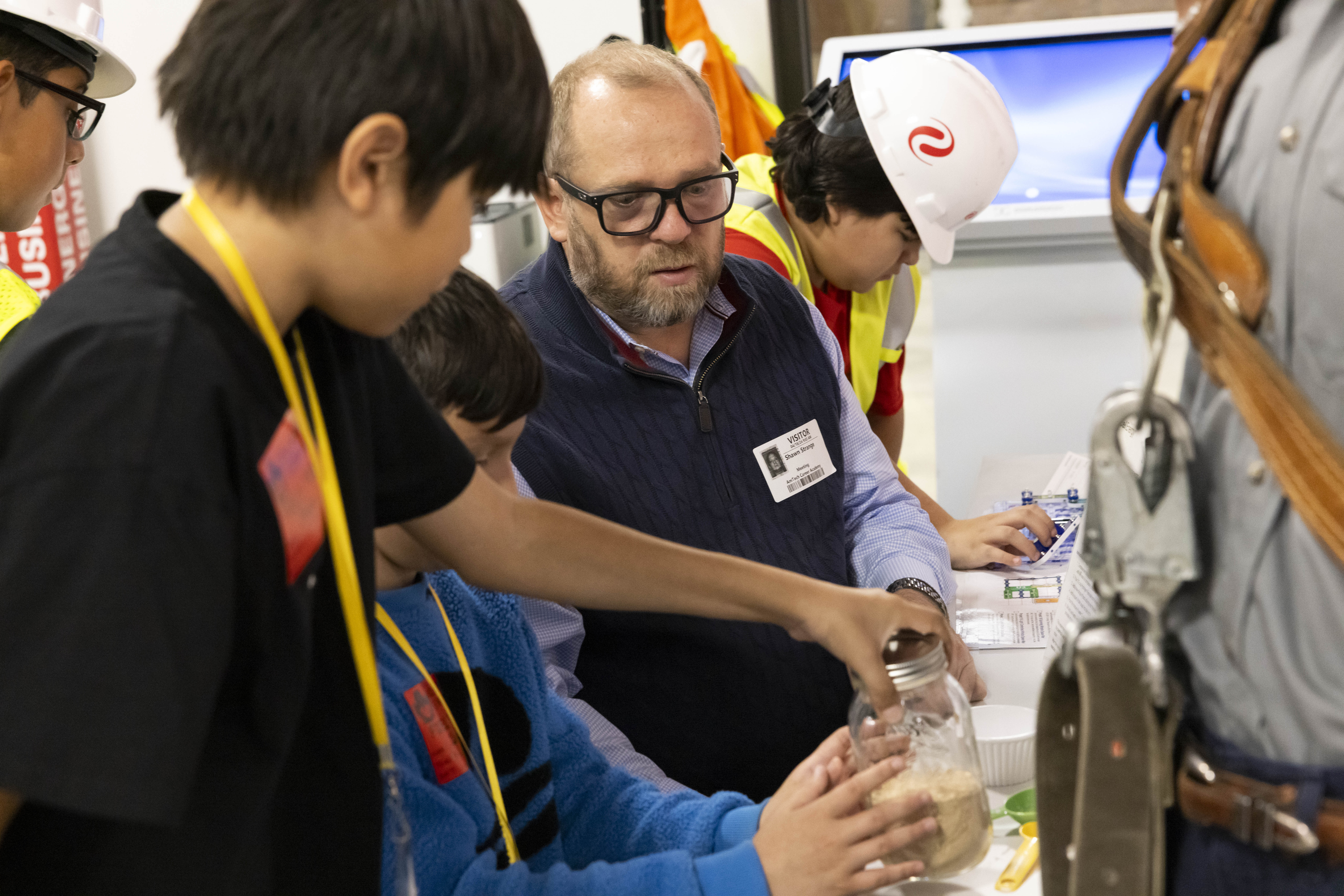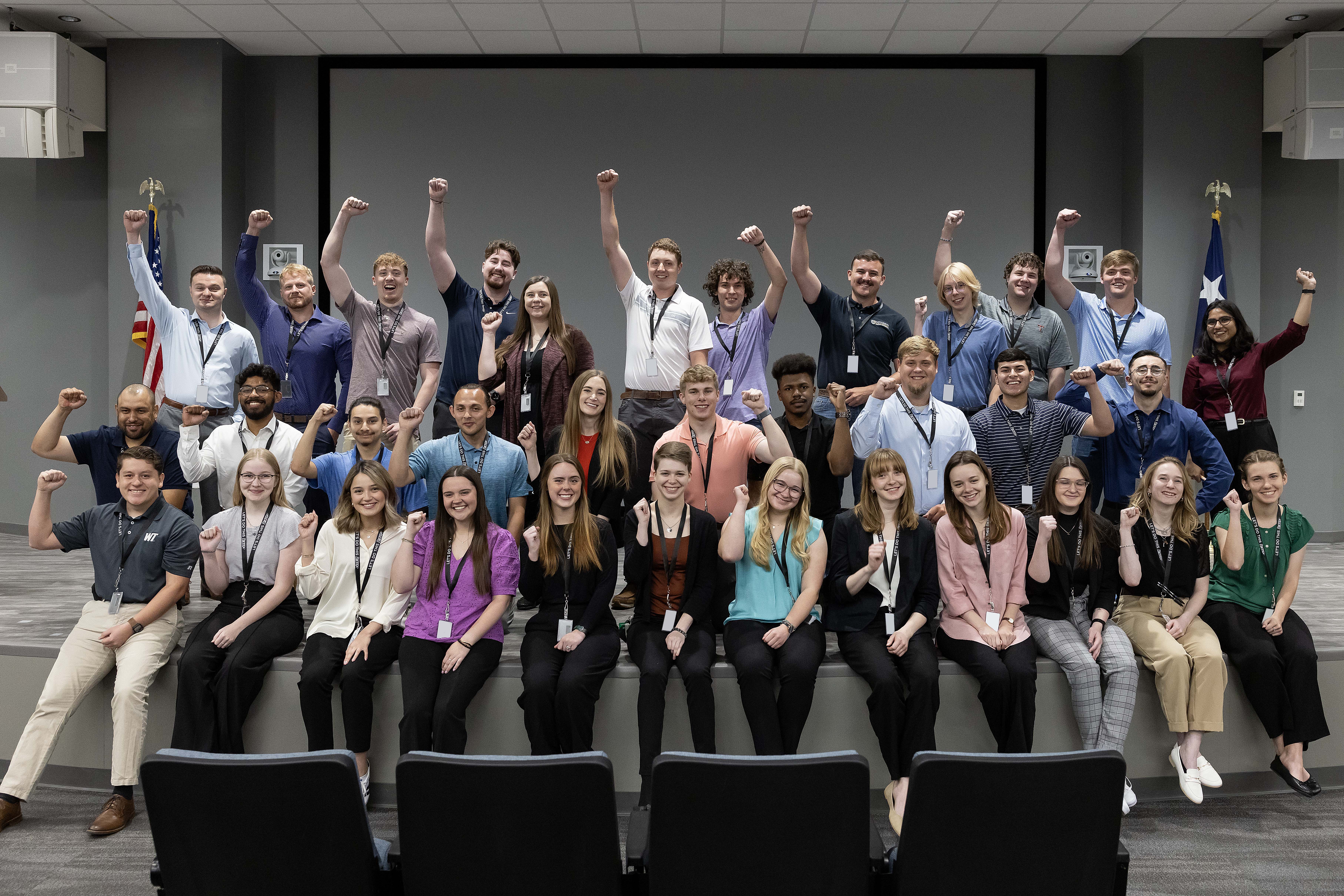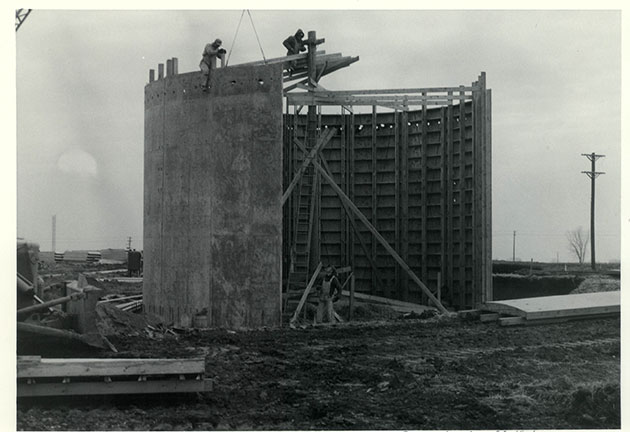Pantex Blog
Teaching life skills and demonstrating excellence

Pantexan Shawn S. interacting with students at JA BizTown.
Balancing a budget, paying bills, taking out loans, and voting in elections are not typical tasks that you think of 5th grade students completing. The reality of these life responsibilities is exposed to Amarillo Independent School District (AISD) students through Junior Achievement (JA) BizTown, located at AmTech Career Academy.
Set up as a simulation town, JA Biztown gives elementary students experience operating banks, managing restaurants, taking out loans, voting in elections, buying cars, and more. Students are connected to real-world educational lessons through this learning experience. In addition to financial literacy, participating in this activity teaches students work and career readiness skills.
Pantex is a proud supporter of the local JA BizTown partnership with AISD. Every month during the 2023-2024 school year, more than a dozen Pantexans have volunteered their time guiding students through the simulation. When the school year ends, Pantex will have donated approximately 1,500 volunteer hours to JA BizTown.
“Our partnership with our Pantex volunteers is invaluable,” Dana W., JA of the High Plains capstone director said. “To see our Pantex volunteers teaching our students how to sound out big words, fill out a check correctly, or just simply pouring into our students that the world is their oyster is something you can’t put a price tag on. Nothing beats harder than the heart of a volunteer!”
One of those dedicated volunteers is Pantex metrology senior manager Shawn S., who can be found volunteering at his usual spot: the Xcel Energy simulation.
“My favorite memory from BizTown is seeing the lightbulb go off in the kids’ heads,” Shawn said. “I think it’s very important for Pantex to interact with our community, and BizTown is a perfect way to do that.”
Pantex’s partnership with abbr title="Amarillo Independent School District">AISD was recently recognized with the distinction of being a district “Partner in Excellence.” Pantex received this honor due to the dedicated volunteers who spent their time teaching and mentoring young students.
“Pantex is one of those outstanding partners who see the value of the work we’re doing to get our young professionals trained, skilled, and ready for the workforce,” AmTech Superintendent Jay Barrett said. “They realize that preparation begins well before high school, which is one reason why they have committed so many volunteer hours to BizTown—we could not do what we do here without them.”
In addition to Pantex’s volunteer work at BizTown, the plant also has a business feature in the simulation, complete with a replica of a wall that is found onsite in the John C. Drummond Center (JCDC).
“This partnership bolsters our need and desire to be an active partner in our communities,” Pantex Site Manager Colby Yeary said. “Attributes such as understanding a citizen’s rights and responsibilities and developing the skills necessary for successful participation in the modern working world are common among both Pantex and BizTown.”
Pantex is proud to give back to its neighbors in the Texas Panhandle and desires to take a dynamic role in helping the surrounding communities. Pantex’s partnership with BizTown and local schools is one way that Pantex employees continue to do just that: helping where they can.
Pantex deputy site manager Kenny Steward with leaders from Junior Achievement of the High Plains in front of Pantex’s feature within BizTown.
CNS intern experience leads to fulfilling careers

Darby L., who interned at Pantex in 2022 and received a job offer after graduation.
Pantex and Y-12 recently welcomed a total of 87 interns from 31 different colleges and universities across the nation. These interns will spend 10 weeks learning about the CNS sites and their missions. They will engage in intense training and learning from their host organizations, culminating in a final project that they will share at the Intern Expo on Tuesday, July 23.
Internships offer students a chance to apply abstract knowledge to form concrete experience. Because of the unique missions at Pantex and Y-12, internship experience gives these graduates an upper-hand in landing a full-time position at one of the sites. From the 2023 intern class, nearly 40% have become full-time employees, with more planning to seek a position at one of the sites after they graduate.
Darby L., who interned at Pantex in 2022 and received a job offer with Pantex Career One after graduation, said that as an Amarillo native, she grew up thinking it would be great to work at Pantex someday.
“Getting to come out to Pantex while I was still in school helped me determine if I wanted to continue working at Pantex as a full-time employee,” Darby said. “I enjoyed the friendly community of Pantex as well as the overall mission statement.”
According to Darby, one of the most important skills she learned from her internship that she still uses in her job now is the ability to communicate effectively.
“In my job, I am always meeting new people as well as learning new things,” she said. “I learned the importance of asking for help when needed as well as asking questions. I have applied the communication skills learned from my internship into my everyday tasks.”
Another former intern, Jovon H., worked at Y-12 in the summer of 2023 and is now working in Y-12 Infrastructure.
“I really enjoyed my internship. I made countless amounts of memories that will be cherished and carried with me through my life,” said Jovon. “Having the luxury of surrounding yourself with people who care about your well-being and have similar missions, goals, and ambitions that further assist you in your career development is not something you find at every company.”
Jovon said that networking was a valuable skill he took from his internship. He truly applied the saying “It’s not so much about what you know as it is who you know.”
“My internship helped me have the capacity and flexibility to build quality relationships with people,” he said. “If no one knows your name, passions, ambitions, and/or face, how can others assist or know what your ultimate goals and ambitions are as an employee?”
To the incoming interns, Darby offered this advice to help them during their internship: “I’d recommend building connections with your employers and fellow interns.”
Jovon echoed the importance of connecting with other people during an internship.
“Communicate and collaborate with each other,” he said. “Coming in, everyone is on the same playing field and is relatable. Also, seek a mentor in your organization who you look up to, and don’t be afraid to fail or ask questions.”

Pantex recently welcomed 38 summer interns from 11 different colleges and universities across the nation.
Working with dad

Pantexan father and daughter, David and Madison, share that the best part of working together is getting to see each other throughout the day.
June is the month to celebrate the fathers in our lives. Some lucky employees have the privilege of working with their fathers on‑site.
Meet Pantexans David and Madison L., father and daughter.
As a technical specialist in Process Engineering, Madison has the opportunity to see and work with her dad on a frequent basis.
“We see each other a lot since we work in the same wing of the JCDC, and we carpool to work,” said David, who is a senior specialist in Nuclear Explosive Safety. “Our roles also intersect. Being a technical specialist, she sends us [Nuclear Explosive Safety] procedures to review.”
Madison, who started at Pantex in December 2022, says her dad has always been the best role model, and she hopes to live up to the reputation that he has made for himself over the course of his 30-year career at Pantex.
“He has taught me to never give up whether in school or just in general,” Madison said. “That has helped me persevere to get to where I am today. He has shown me how to treat others no matter what environment I’m in, and that I should always be respectful and kind.”
For David, his proudest moments as a father are representative of the example he’s set for his daughter.
“Madison is a very kind and generous person with a big heart. My first proudest moment was watching her being baptized and second when she graduated from Texas Tech University in 3 years,” David said. “It showed her determination and desire to reach her goals.”
Protecting personnel and property for the mission

Carlos G., fire protection engineer, conducts a monthly prevention check on equipment.
With approximately 500 facilities at Pantex and more than 400 at Y-12, protecting the lives and property inside each building is an essential job. Fire protection engineers work daily to ensure the safety of personnel and property.
“With Pantex being the primary nuclear weapons plant, a fire in a nuclear or explosive facility would cause a huge impact to the nuclear deterrent for the United States and our allies,” said Justin H., Pantex Fire Protection Engineering manager. “A fire could cause an explosion, contamination, or worse, the loss of life.”
Justin’s Y-12 counterpart, Jake G., echoed the importance of mitigating fire dangers.
“In addition to the off-site release concerns associated with a fire, any major fire at the site could cause an extended shutdown,” said Jake, Y-12 Fire Protection Engineering manager. “Understanding the potential consequences of a major fire and the associated impact to not only the site but the employees is how I feel I contribute to the overall mission of Y-12.”
Fire protection engineers serve as the technical authority on fire protection–related items. They also review combustibles that are present in nuclear facilities, perform fire modeling, and review procedures to verify that all operations are implementing fire safety controls.
“Knowing that my job directly protects my Pantex coworkers by ensuring their safety as well as the safety of the surrounding community is very rewarding,” said Fire Protection Engineer, Carlos G.
Only a handful of universities offer fire protection engineering degrees. Justin, Jake, and Carlos all earned their degrees at Oklahoma State University where, in addition to the regular curriculum of math and science courses, they worked hands-on in fire labs.
“I interviewed with Pantex at the OSU career fair and accepted an offer a couple of months before graduating. I knew it would be a one-of-a-kind experience and opportunity,” Carlos said. “I had also heard great things from friends and previous classmates who had been hired on before me. I have been a proud Pantexan for 4 1/2 years.”
It is easy for anyone to get bogged down in the daily grind, but at the end of the day, remembering how the work impacts the overall mission is rewarding.
“My favorite part of the job is being able to assist in solving issues associated with the unique and one-of-a-kind processes, equipment, and hazards that we have at Y-12,” Jake said.
Justin shares similar sentiments with Jake and other Fire Protection Engineering colleagues. Each voiced a selfless dedication to the wellbeing of their sites and the people who work there.
“It is gratifying when you take a step back and think about how Pantex is a place in the Nuclear Security Enterprise that deters other countries from using nuclear weapons,” Justin said. “Knowing you have played a role in that mission is rewarding.”
The Burlington-Pantex Transfer

This historic image shows a building at Burlington under construction in 1957. The work at the Iowa facility was transferred to Pantex in 1974.
The early 1970s was a tumultuous time, with the Vietnam War raging and major political upheaval. Americans were struggling with the rising cost of living and a looming gas crisis. The Cold War was still in full swing, and the facilities that actively participated in ensuring the United States’ nuclear security were numerous.
At the time, there were about 30 places that had a role in the work; today less than 10 facilities make up the Nuclear Security Enterprise, including Pantex and Y-12.
At the time, a factory at Burlington, Iowa, was doing assembly and disassembly work, and that site was chosen to be closed and consolidated.
Fifty years ago this year, the mission performed at Burlington was in the process of being moved to Pantex. At the time, both facilities were managed by Mason & Hanger.
“The government did a study to look at cutting costs and consolidate the work into a couple of plants, instead of having it spread around,” said employee Katie P. “One of the reasons Pantex was chosen is it would have cost $30 million in 1974 money to move the work Pantex did up to Burlington, but only $10 million to move the work done at Burlington down here.”
Some of the other advantages that Pantex had were adequate space, updated facilities, better weather, and a larger nearby city—as well as a major advocate in the form of John C. Drummond, for whom the flagship office building at the facility is now named.
Employees made the move in 1974, and among them was Harvey B., who continues to work at Pantex.
Harvey began working at Burlington shortly after graduating college, and met his wife there. Once they made the move to Pantex, a local employee tried to help them get settled in to their new home.
“He gave us a local tour, took us to Lake Meredith. He was proud of this area,” Harvey remembered. “It was different. My wife grew up with trees. Down here, if you want one, you have to plant it. We got home, and [my wife] said, ‘It looked to me like the moon.’”
Today, Pantex is preparing for more change as its management and operating contractor is set to be changed this year. One of the enduring truths at Pantex is the need to adapt to change while continuing to perform the mission without missing a beat.
“Fifty years ago, our mission we still carry out today really got consolidated,” Katie said. “It was a time of change, not only for the U.S., but also for people locally.
“Now, instead of consolidating, we’re growing, getting more duties and getting new people who are becoming part of our family and our culture,” she continued. “We have endured change before, but now we’re in a new era. There is a lot of stuff going on. It’s a different time, but a similar story of change happening then and now.”
